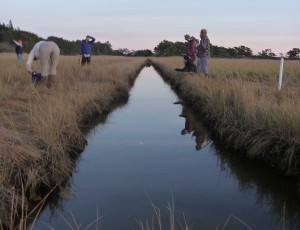Classes
ES/EA 226. Hydrogeology.
Hydrogeology is the study of the movement and interaction of underground fluids within rocks and sediments. This course uses hydrogeology as a disciplinary framework for learning about groundwater processes, contamination, supply, use, and management. Students engage in practical applications of hydrogeology via discussions, guest lectures, research projects, problem sets, and hands-on experience. Students learn field and laboratory methods for determining and analyzing groundwater flow, contamination, and aquifer properties by working at local sites of interest in central Maine.
____________________________________________________________
EACS 108. Global Environmental Change.
Earth’s system is comprised of the dynamic interactions between its various components: the biosphere, lithosphere, hydrosphere, and the atmosphere. Currently, humans are perturbing these components at unprecedented rates, resulting in environmental change on regional and global scales. In this course, students examine the Earth system on multiple timescales and investigate current topics in global change, including the impact of greenhouse gases on global climate, sea level, El Niño, global dimming, and ocean acidification. Two required day-long field trips to the Maine coast take place on weekends.
.
EACS 109. Global Change.
The Earth’s system is comprised of the dynamic interactions between its various components: the biosphere, lithosphere, hydrosphere, and the atmosphere. Mounting evidence indicates that humans are perturbing these components at unprecedented rates, resulting in environmental change on regional and global scales. In this course, students examine the Earth system on multiple timescales and investigate current topics in global change, including the impact of greenhouse gases on global climate, sea level, El Ni?o, global dimming, and ocean acidification. Laboratories include field trips to sites that illustrate environmental change on local and regional scales.
.
EACS 240. Environmental Geochemistry.
This course is an introduction to the chemistry of geological processes that occur at the Earth’s surface. Basic concepts of rock-water interactions, chemical equilibria, and biogeochemical cycling are presented in the context of natural settings as well as those influenced by anthropogenic activity. Students work on local environmental problems, which may include surface and groundwater contamination by salt, arsenic, nutrients, and/or heavy metals; acid mine drainage; and the history of lead deposition. The laboratory includes fieldwork and GIS, chemical analysis of environmental samples using inductively coupled plasma emission spectroscopy, and stable isotope ratio mass spectrometry and modeling using STELLA.
ES/EA s21. Field Studies in Geology.
This course introduces students to field studies in geology. Three different geologic settings (bedrock geology, geomorphology, and hydrology) are the focus of three week-long field projects. Each project is followed by laboratory analysis and compilation of the field data in the form of maps, cross sections, and lab reports. Students learn how to map and analyze spatial datsets using mobile GIS field methods and ArcGIS techniques as well as methods in environmental sampling and modeling. Students examine exposures of bedrock on the Maine coast, glacial features in downeast Maine, and river systems in central Maine. This course provide students with a basic toolkit for fieldwork in geology and environmental studies. Co-taught with Prof. Dyk Eusden.
.
